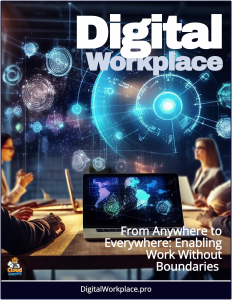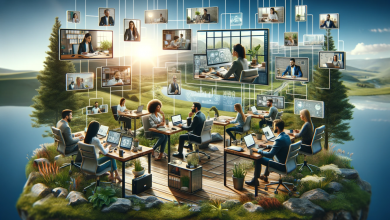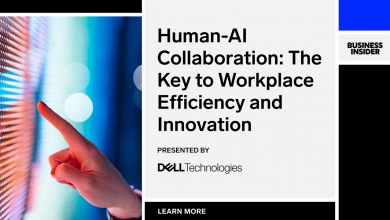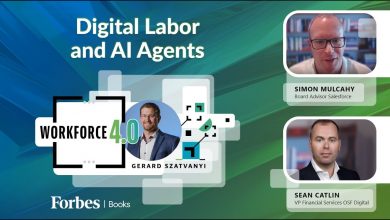 In an era defined by unprecedented change, the digital workplace has emerged as the linchpin of organizational success, enabling businesses to thrive in a world where flexibility, connectivity, and employee empowerment are paramount.
In an era defined by unprecedented change, the digital workplace has emerged as the linchpin of organizational success, enabling businesses to thrive in a world where flexibility, connectivity, and employee empowerment are paramount.
The convergence of transformative trends—hybrid work, artificial intelligence (AI), heightened security demands, and sustainability—has reshaped how enterprises operate, compelling senior executives to reimagine the workplace.
The Imperative of the Digital Workplace
The modern workplace is no longer confined to physical offices; it is a dynamic, technology-driven ecosystem that empowers employees to work from anywhere, anytime, and on any device. The rise of hybrid work models, with over 70% of global companies offering flexible arrangements has accelerated the demand for digital workplace solutions.
These tools—ranging from Microsoft Teams for seamless communication to Azure Virtual Desktop for secure access—enable organizations to bridge geographical divides, ensuring teams remain connected and productive. For executives, the stakes are high: a well-executed digital workplace strategy not only boosts efficiency but also attracts top talent, enhances employee engagement, and drives innovation in a competitive landscape.
A Unified Vision: Key Categories of the Digital Workplace
The digital workplace is a tapestry of interconnected technologies, each addressing specific needs while collectively fostering collaboration and community.
Collaboration Intranets, such as SharePoint and Simpplr, serve as centralized hubs for knowledge sharing, housing documents, wikis, and newsfeeds that empower employees to access and contribute expertise. These platforms break down silos, enabling a marketing team to share campaign assets globally or a product team to co-edit specifications in real time.
Unified Communications platforms like Zoom and Cisco Webex unify voice, video, and chat, enhanced by AI-driven features like real-time transcription and translation, ensuring inclusive communication for diverse, hybrid teams.
Virtual Desktop Infrastructure (VDI) and Desktop as a Service (DaaS), exemplified by VMware Horizon Cloud and Citrix DaaS, deliver secure, scalable desktop environments, allowing employees to access applications from any device. While VDI offers customization for complex needs, DaaS provides simplicity and rapid deployment, both critical for secure collaboration in regulated industries like healthcare.
Enterprise Social Networks like Yammer and Workplace by Meta create virtual watercoolers, fostering informal interactions and recognition that strengthen organizational culture. Employee Feedback Platforms, such as Qualtrics and 15Five, provide real-time insights into employee sentiment, enabling leaders to address remote work challenges like isolation or burnout.
Hybrid Work Solutions integrate these tools to ensure seamless transitions between remote and on-site work, combining Teams’ video capabilities with Azure Virtual Desktop’s secure access to support flexible workflows.
End User Computing (EUC) ties it all together, with tools like Microsoft Intune for desktop application management ensuring software consistency and VMware Carbon Black for endpoint security protecting distributed devices. Together, these categories create a cohesive digital workplace that empowers employees and drives organizational agility.
Addressing Remote Work Challenges
Remote and hybrid work have introduced challenges that digital workplace solutions are uniquely positioned to address. Communication barriers are mitigated by UC platforms, where AI-driven features like Zoom’s noise suppression ensure clarity in virtual meetings, while Teams’ integration with SharePoint streamlines document sharing.
Isolation is countered by ESNs and Feedback Platforms, with Workvivo’s recognition tools and Qualtrics’ sentiment analysis fostering connection and well-being. Resource access is ensured through VDI/DaaS, enabling a remote engineer to use Citrix DaaS for high-performance applications on a low-powered device.
Security risks, a growing concern noted on X, are addressed by EUC’s endpoint protection and zero-trust models in platforms like Azure Virtual Desktop, ensuring compliance with GDPR and HIPAA. Digital literacy challenges are tackled through intuitive interfaces and robust training, ensuring all employees can leverage tools like Simpplr or 15Five effectively.
The Power of AI and Emerging Trends
AI is the heartbeat of the modern digital workplace, transforming how teams collaborate and leaders make decisions.
In UC, AI-driven transcription in Microsoft Teams’ Copilot or Zoom’s AI Companion captures meeting insights, while real-time translation fosters inclusivity for global teams. In VDI/DaaS, AI optimizes resource allocation, as seen in VMware Horizon Cloud, ensuring performance for resource-intensive tasks.
Feedback Platforms like Qualtrics use AI to analyze sentiment, guiding leaders to address remote worker needs proactively. ESNs leverage AI for personalized content recommendations, enhancing engagement on platforms like Workplace by Meta.
Beyond AI, 2025 trends underscore the importance of hybrid work optimization, with mobile-first designs in tools like Zoom ensuring accessibility for on-the-go employees.
Sustainability is a priority, with cloud-based solutions like AWS WorkSpaces reducing hardware reliance, aligning with corporate environmental goals. Zero-trust security, integrated into Citrix DaaS and Microsoft Defender, protects distributed workforces, while interoperability with legacy systems, as seen in Cisco Webex, ensures flexibility. These trends position the digital workplace as a strategic asset for forward-thinking organizations.
A Methodology for Success
Implementing a digital workplace requires a disciplined approach, encapsulated in a five-phase methodology: Plan, Design, Deploy, Adopt, and Optimize. In the Plan phase, executives define objectives, such as enhancing remote collaboration or securing data, and establish KPIs like adoption rates or engagement scores.
The Design phase architects a cohesive solution, integrating platforms like Teams, SharePoint, and Intune with SSO and AI-driven features. Deploy involves piloting tools, testing performance (e.g., VDI latency, UC uptime), and validating security.
The Adopt phase drives engagement through training, champions, and communication campaigns, ensuring employees embrace tools like Qualtrics or Yammer. Finally, the Optimize phase leverages analytics from Simpplr or Teams to refine performance, addressing feedback and scaling resources.
A Call to Action for Executives
The digital workplace is not just a technological framework; it is a strategic imperative that redefines how organizations operate, innovate, and engage. For senior executives, the opportunity is clear: invest in a digital workplace that empowers employees, fosters collaboration, and drives resilience.
By leveraging Collaboration Intranets to centralize knowledge, UC to unify communication, VDI/DaaS for secure access, ESNs for community, Feedback Platforms for insights, Hybrid Work Solutions for flexibility, and EUC for seamless management, leaders can build a workplace that thrives in uncertainty.
The future of work is here, and it demands bold vision. Embrace these technologies to create a connected, inclusive, and innovative organization. As you navigate this journey, pilot solutions, listen to employee feedback, and align with trends like AI and sustainability. The digital workplace is your canvas—paint it with purpose, and lead your organization into a future where work knows no boundaries.



